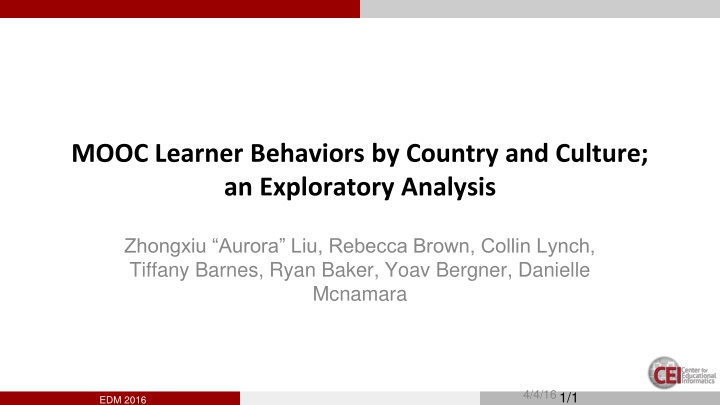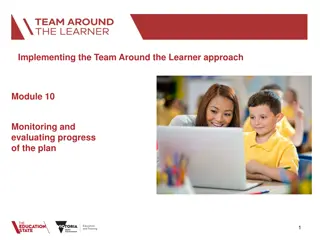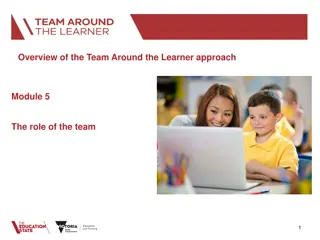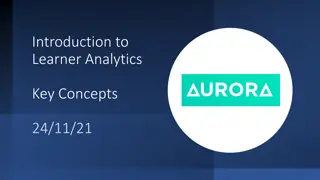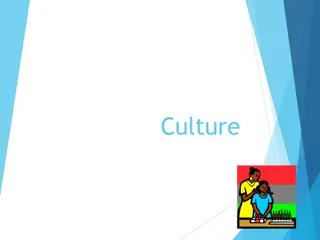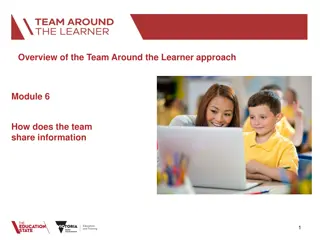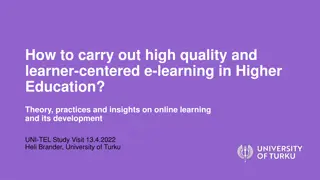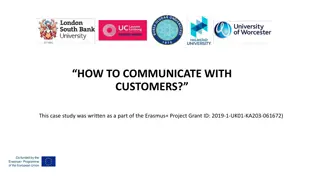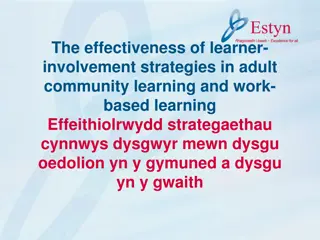Cross-Cultural Analysis of MOOC Learner Behaviors
Explore the impact of culture on Massive Open Online Courses (MOOCs) through research on learner behaviors, including approaches like data mining and machine learning. Understand how educational technology research with cultural awareness and theoretical frameworks can inform cross-cultural data analysis in e-learning systems.
Download Presentation

Please find below an Image/Link to download the presentation.
The content on the website is provided AS IS for your information and personal use only. It may not be sold, licensed, or shared on other websites without obtaining consent from the author.If you encounter any issues during the download, it is possible that the publisher has removed the file from their server.
You are allowed to download the files provided on this website for personal or commercial use, subject to the condition that they are used lawfully. All files are the property of their respective owners.
The content on the website is provided AS IS for your information and personal use only. It may not be sold, licensed, or shared on other websites without obtaining consent from the author.
E N D
Presentation Transcript
MOOC Learner Behaviors by Country and Culture; an Exploratory Analysis Zhongxiu Aurora Liu, Rebecca Brown, Collin Lynch, Tiffany Barnes, Ryan Baker, Yoav Bergner, Danielle Mcnamara 4/4/161/1 EDM 2016
How Should E-learning Platforms Respond to Culture? HarvardX MOOCs Registrants (Nesterko, 2013) EDM 2016
Educational Technology Research With Cultural Awareness In the past decade, there has been substantial increase in studying cross-cultural behaviors in e-learning systems Approach 1: Coding behaviors through field observations (Rodrigo et al., 2013; Ogan et al., 2015) Approach 2: Data-mining (Ogan et al., 2015; Saarela et al., 2015) Challenge: Interpretation. why these differences occur? and how to relate to more general cross-cultural variation? 4/4/16 3
Massive Open Online Courses (MOOC) Common Research Focuses: Dropout, Engagement Approach 1: Predicting with machine learning models (Wen&Rose, 2014; Brooks et al., 2015) Approach 2: Detecting subgroups through clustering students(Kizilcec, 2015; Ferguson, 2015; Anderson, 2014; Bergner, 2015) Usually use clickstream data to create features such as the freq. of major activities, or ratios between major activities 4 4/4/16
MOOC Recent focus: understanding learner background Prior work related demographic and motivational surveys to course completion (Wang&Baker, 2015; Deboer, 2013) However, few research related geographical information to learner behaviors (Guo&Reineck, 2014): applied linear regression and found country related to freq of reviewing earlier materials. This work attributed result to teacher/student ratio (Kizilec et al., 2013): Broke countries into HDI tiers. Found as Human Development Index increases, the proportion of course completers increases Limitation: These research treated country as an independent factor. No theoretical models to connect results to the impact of culture 5 4/4/16
Theoretical Frameworks for Cross-cultural Data Analysis Hofstede s Cultural Dimensions Theory (Hofstede, 2010) Cultural Dimensions of Learning Framework (CDLF) (Parrish et al.,2010) Power distance: high-> teacher is of greater authority Individualism: high ->students speak up more, and value diverse opinions in learning Masculinity: high-> students like competitions, and have more need for recognition Uncertainty Avoidance: high -> students focus more on right answers and structured learning 6 4/4/16
In this Work Analyzed data from 1 MOOC, with 29,149 registrants from 172 countries Used Hofstede s Cultural Dimensions, and Cultural Dimensions of Learning Framework (CDLF) Found clear and explainable inter-cultural differences in learner behaviors 7 4/4/16
Data An 8-week long Coursera MOOC Big Data in Education Video lectures; discussion forum; weekly auto-graded quizzes (multi-choice or numerical input) with 3-5 attempts allowed in two weeks. Grade: 6 highest/8 quizzes; students can achieve normal/distinction certificates Clickstream data from 29149 students, 172 countries User id, url (identify activity), timestamp, ip (identify country) 638 got certifications 750 posted in forum 27558 bystanders 8 4/4/16
Data From clickstream data, we extracted major activities: VL: view lectures AQ, SQ: attempt/submit quizzes RP, MP: read posts, make posts Limitation: clickstream data represent the initial access of course activities, no information on time spent on the activities. 9 4/4/16
Roadmap of Research Questions Identify categories of Users (RQ1: Course Activity Profiles) Country-wise differences? (RQ2: CAP distr. By Country) Hofstede Cultural Dimensions Delve into each CAP s behavior Culture-wise Differences? (RQ4: QAP by Country) (RQ5: Forum Best Friend) Segment activities around Quiz (RQ3: Quiz Activity Profiles) Activities in Forum (Brown et al., 2015; Fire et al., 2012) 4/4/16 10
RQ1: Course Activity Profiles (CAPs) Q: What are the main categories of students, based on the total and relative frequencies of accessing different course activities? Method: we hierarchically clustered students on number of lectures viewed and quizzes attempted 11 4/4/16
RQ1: Course Activity Profiles (CAPs) 5 CAPs, closely resembles previous work (Anderson et al., 2014) All-rounders, who had a balance number of lectures viewed and quizzes attempted had the highest rate of receiving certificate 4/4/16 12
RQ1: Course Activity Profiles (CAPs) 5 CAPs, closely resembles previous work (Anderson et al., 2014) All-rounders, who had a balance number of lectures viewed and quizzes attempted had the highest rate of receiving certificate In later analysis, we focus on three categories with sufficient activities and good Average Silhouette Value (ASW) (Rousseeuw,1987) 4/4/16 13
RQ2: CAPs by Country Q: Does the proportion of CAP differ by country? Method: we hierarchically clustered countries based on CAP distribution 14 4/4/16
RQ2: CAPs by Country Cluster 1: contains all developing countries + Singapore Cluster 3: contains all developed countries Proportion of solver in Cluster1 is significantly higher than Cluster 3 (p<0.001) 15 4/4/16
RQ3: Quiz Activity Profiles (QAP) Q: When does each category access each type of course activity, relative to quiz submissions? Method: We applied the Kruskal-Wallis Test (Northcutt et al., 1952) with Benjamini Hochberg correction (Benjamini&Hochberg, 1995), to compare major activity frequencies. 4/4/16 16
RQ3: Quiz Activity Profiles (QAP) Both solvers and all-rounders viewed most lectures between quizzes, and read most posts during subsequent quiz submissions (p<0.01) 17 4/4/16
RQ4: QAP by Culture Q:How do quiz-related profiles relate to culture clusters Method: Countries to culture clusters: hierarchically clustered countries on Hofestede s Cultural Dimension numbers (Hofstede&Hofstede, 2010) Kruskal-wallis & Benjamini Hochberg Correction 18 4/4/16
RQ4: QAP by Culture Cultural clusters overlap with CAP clusters. Cluster 1 is a subset of all- rounder dominant CAP cluster; Cluster 3 is a subset of solver dominant CAP cluster. Cluster 2&3: solvers read *significant, or marginally significant fewer posts, during multiple learning phases Cluster3: solvers viewed less lectures between quizzes; all- rounders viewed more lectures during first quiz attempt, and submitted quizzes more times 19 4/4/16
RQ5: Forum Best friend Q: Is a student s most frequent forum partner in the same country/culture? Method: best friend in forum interaction (Brown et al., 2015; Fire et al., 2012) U.S., cluster 1 China, cluster 3 Canada, cluster 1 Forum Community Example We applied chi-squared test: groups (in/out a cultural cluster or country) categories (forum best friend in/out the cultural cluster or country) 4/4/16 20
RQ5: Forum Best friend For all Culture Clusters, students are significantly more likely to have best friend from the same culture China and Brazil are significantly more likely to have best friends in their own countries 21 4/4/16
Discussion What did we learn?: Student behaviors in MOOC despite cultural influence. Identify categories of Users (RQ1: Course Activity Profiles) Country-wise differences? (RQ2: CAP distr. By Country) Delve into each CAP s behavior Hofstede Cultural Dimensions Segment activities around Quiz (RQ3: Quiz Activity Profiles) Activities in Forum (Brown et al., 2015; Fire et al., 2012) Culture-wise Differences? (RQ4: QAP by Country) (RQ5: Forum Best Friend) 22 4/4/16
Students behaved in this MOOC despite Culture influence. RQ1: Course Activity Profiles We found similar CAPs as in prior work. A balanced ratio of lectures viewing and quiz attempts is a good indicator of students who are working towards a certificate. RQ3: Quiz Activity Profiles Regardless of CAPs, students viewed most lectures between quizzes and most forum posts during the subsequent quiz attempts. This resembles activities in traditional classroom setting. 23 4/4/16
Discussion What did we learn?: CAP and Culture Clusters. Identify categories of Users (RQ1: Course Activity Profiles) Country-wise differences? (RQ2: CAP distr. By Country) Delve into each CAP s behavior Hofstede Cultural Dimensions Segment activities around Quiz (RQ3: Quiz Activity Profiles) Culture-wise Differences? (RQ4: QAP by Country) (RQ5: Forum Best Friend) Activities in Forum (Brown et al., 2015; Fire et al., 2012) 4/4/16 24
Country Clusters by CAP and by Culture. RQ2: Country Clusters by CAP We found cluster 1 has higher percentage of solver. These countries (mostly developing countries) may study off-line, or use MOOC as a certificate system for career advancement Solver Dominant: China, India, Singapore Russia, Brazil, All-rounder Dominant U.S., U.K., Netherlands, Spain, Germany, Australia, Canada, RQ2 and Cultural Clusters Culture cluster (India, Singapore, China) is a subset of solver-dominant cluster. This high % of solver may due to Asian s exam-centric education. (Leung, 2011; Wong, 2004) China, India, Singapore Brazil, France Russia, Spain, U.S. Australia, Canada, U.K. 25 4/4/16
Discussion Country-wise differences? (RQ2: CAP distr. By Country) Identify categories of Users (RQ1: Course Activity Profiles) Hofstede Cultural Dimensions Delve into each CAP s behavior Segment activities around Quiz (RQ3: Quiz Activity Profiles) Culture-wise Differences? (RQ4: QAP by Country) (RQ5: Forum Best Friend) Activities in Forum (Brown et al., 2015; Fire et al., 2012) Culture-wise differences in major activities 26 4/4/16
Activity Frequencies in QAP RQ4: QAP distr. by Country For solver: cluster 1&2 with lower individualism and higher power distance compared to cluster 3, read less forum posts between and during quizzes Explainable by CDLF: teachers in clusters 1&2 are treated with higher authority, while diverse opinions in learning are valued less. For solver: cluster 1 viewed less lectures between quizzes For all-rounder: cluster 1 viewed more lectures during the first quiz submission and submit quizzes more times Not explainable by CDLF. Explainable by the exam-centric educational culture in Asia. . (Leung, 2011; Wong, 2004). Students arranged more activities around quizzes, and focused more on getting the quizzes correct. China, India, Singapore Russia, Spain, Brazil, France U.S. Australia, Canada, U.K. 27 4/4/16
Forum Interactions RQ5: Forum Best Friend Students had significantly more best friends within their own culture clusters, and within China and Brazil Students from different cultures view the role of shared discussion differently (CDLF) Language barriers Students from the some country know each other outside this MOOC 28 4/4/16
Discussion Identify categories of Users (RQ1: Course Activity Profiles) Country-wise differences? (RQ2: CAP distr. By Country) Delve into each CAP s behavior Hofstede Cultural Dimensions The Big Picture Segment activities around Quiz (RQ3: Quiz Activity Profiles) Culture-wise Differences? (RQ4: QAP by Country) (RQ5: Forum Best Friend) Activities in Forum (Brown et al., 2015; Fire et al., 2012) 29 4/4/16
Discussion Different cultures and countries exhibited different learning behaviors, explainable by CDLF and educational culture. In general, learner behaviors are related to the importance of learning activities within learners country and culture 30 4/4/16
Contribution & Future Work Contribution: This study increased the understanding of different behaviors within MOOC population, and how these differences related to cultural and educational differences. Addressed important research issues in e-learning Combined results with theoretical framework Proposed novel analyses Future Work Generalizability of findings: we can easily apply this methods to other e-learning platforms, but will the same results stand? Design Implications: need more studies to find out: should MOOC designers intervene? One MOOC for all, or cultural-tailored track? 31 4/4/16
A. Anderson, D. Huttenlocher, J. Kleinberg, and J. Leskovec. Engaging with massive online courses. In the 23rd ACM Int. conf. on World Wide Web, pages687-698, 2015 Y. Benjamini and Y. Hochberg. Controlling the false discovery rate: a practical and powerful approach to multiple testing. Journal of the Royal Statistical Society. Series B (Methodological), 289-300, 1995. Y. Bergner, D. Kerr, and D. E. Pritchard. Methodological challenges in the analysis of MOOC data for exploring the relationship between discussion forum views and learning outcomes. In The 8th Int. conf. on Educational Data Mining, 2015. C. Brooks, C. Thompson, and S. Teasley. A time series interaction analysis method for building predictive models of learners using log data. In the Fifth Int. conf. on Learning Analytics And Knowledge, pages 126-135, 2015. R. Brown, C. Lynch, Y. Wang, M. Eagle, J. Albert, T. Barnes, R. Baker, Y. Bergner, and D. McNamara. Communities of performance & communities of preference. In the 2nd Int. Workshop on Graph-Based Educational Data Mining, 2015. J. DeBoer, G. S. Stump, D. Seaton, and L. Breslow. Diversity in MOOC students' backgrounds and behaviors in relationship to performance in 6.002 x. In the Sixth Learning Int. Networks Consortium conf.,2013. R. Ferguson and D. Clow. Examining engagement: analysing learner subpopulations in massive open online courses (MOOCs). In the Fifth Int. conf. on Learning Analytics And Knowledge ACM, pages 51-58, 2015. M. Fire, G. Katz, Y. Elovici, B. Shapira, and L. Rokach. Predicting student exam's scores by analyzing social network data. In the 7th Int. Workshop on Active Media Technology, 2012. P. J. Guo and K. Reinecke. Demographic differences in how students navigate through MOOCs. pages 21-30, 2014. 32 4/4/16
G. Hofstede and G. J. Hofstede. Cultures and organizations: Software of the mind (3rd ed.). McGraw-Hill, New York, USA, 2010 R. F. Kizilcec, C. Piech, and E. Schneider. Deconstructing disengagement: Analyzing learner subpopulations in massive open online courses. In the 3rd Int. conf. on learning analytics and knowledge, pages 170-179, 2013. F. K. Leung. In search of an East Asian identity in mathematics education. Educational Studies in Mathematics, 17(1), 35-51, 2001 S. Nesterko, D. Seaton, J. Reich, and I. Chuang. Evaluating Geographic Data in MOOCs. NIPS Workshop on Data Driven Education (pp. 1 7). 2013. C. G. Northcutt, A. D. Ho, and I. L. Chuang. Use of ranks in one-criterion variance analysis. Journal of the American statistical Assoc., 47(260):583-621, 1952. A. Ogan, B. R. Walker, E., M. M. T. Rodrigo, J. C. Soriano, and M. J. Castro. Towards understanding how to assess help-seeking behavior across cultures. Int. Journal of Artificial Intelligence in Education, 25(2):229-248, 2015. A. Ogan, E. Yarzebinski, P. Fernandez, and I. Casas. Cognitive tutor use in Chile: Understanding classroom and lab culture. In the 17th Int. conf. on Artificial Intelligence in Education, pages 318-327, 2015. P. Parrish and J. Linder-VanBerschot. Cultural dimensions of learning: Addressing the challenges of multicultural instruction. The Int. Review of Research in Open and Distributed Learning, 11(2), 2010. M. M. T. Rodrigo, R. S. J. D. Baker, and L. Rossi. Student off-task behavior in computer-based learning in the Philippines: comparison to prior research in the usa. Teachers College Record, 115(10):1-27, 2013. P. J. Rousseeuw. Silhouettes: a graphical aid to the interpretation and validation of cluster analysis. Journal of computational and applied mathematics, 20:53-65, 1987. 33 4/4/16
M. Saarela and T. Karkkainen. Do country stereotypes exist in PISA? a clustering approach for large, sparse, and weighted data. In the 8th Int. conf. on Educational Data Mining, 2015. Y. Wang and R. Baker. Content or platform: Why do students complete MOOCs? MERLOT Journal of Online Learning and Teaching, 11(1), 17-30, 2015. M. Wen and C. P. Ros e. Identifying latent study habits by mining learner behavior patterns in massive open online courses. In the 23rd ACM Int. conf. on Information and Knowledge Management, pages 1983-1986, 2014. J. K. K. Wong. Are the learning styles of Asian int. students culturally or contextually based? Int. Education Journal, 4(4), 154-166, 2004. M. Zhu, Y. Bergner, Y. Zhang, R. Baker, E. Wang, and L. Paquette. Longitudinal engagement, performance, and social connectivity: a MOOC case study using exponential random graph models. In The 6th Int. conf. on Learning Analytics and Knowledge, 2016 34 4/4/16
Thank you! 4/4/16 35
